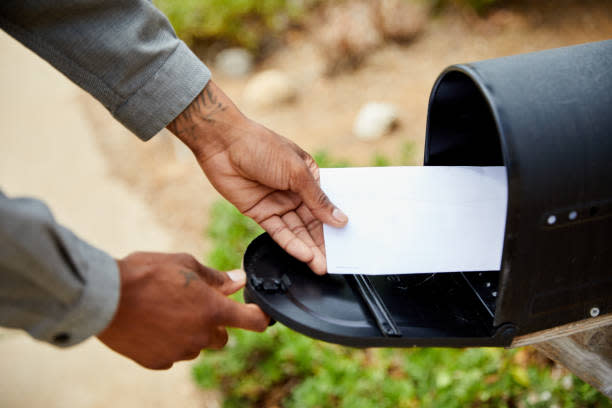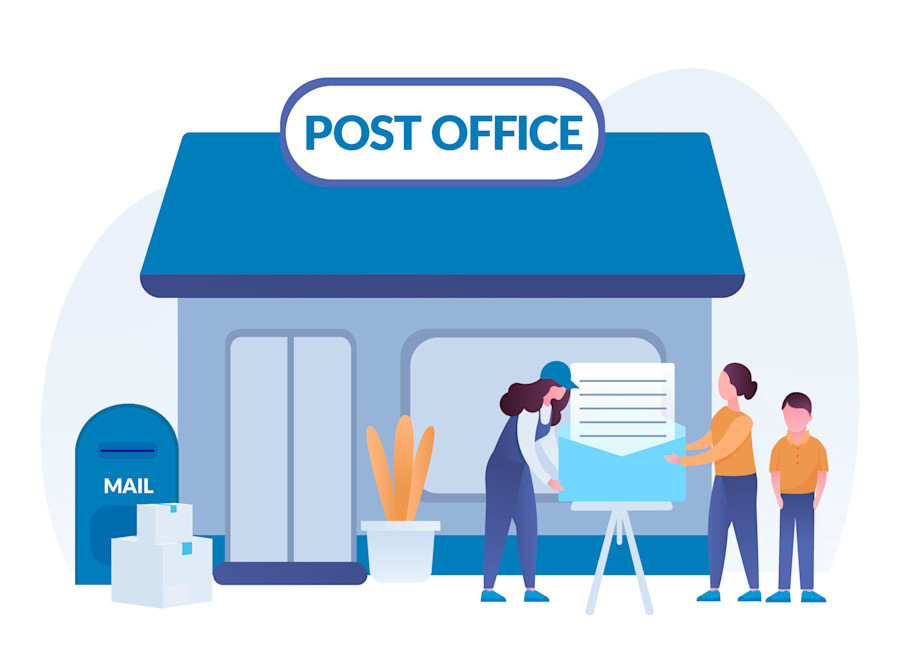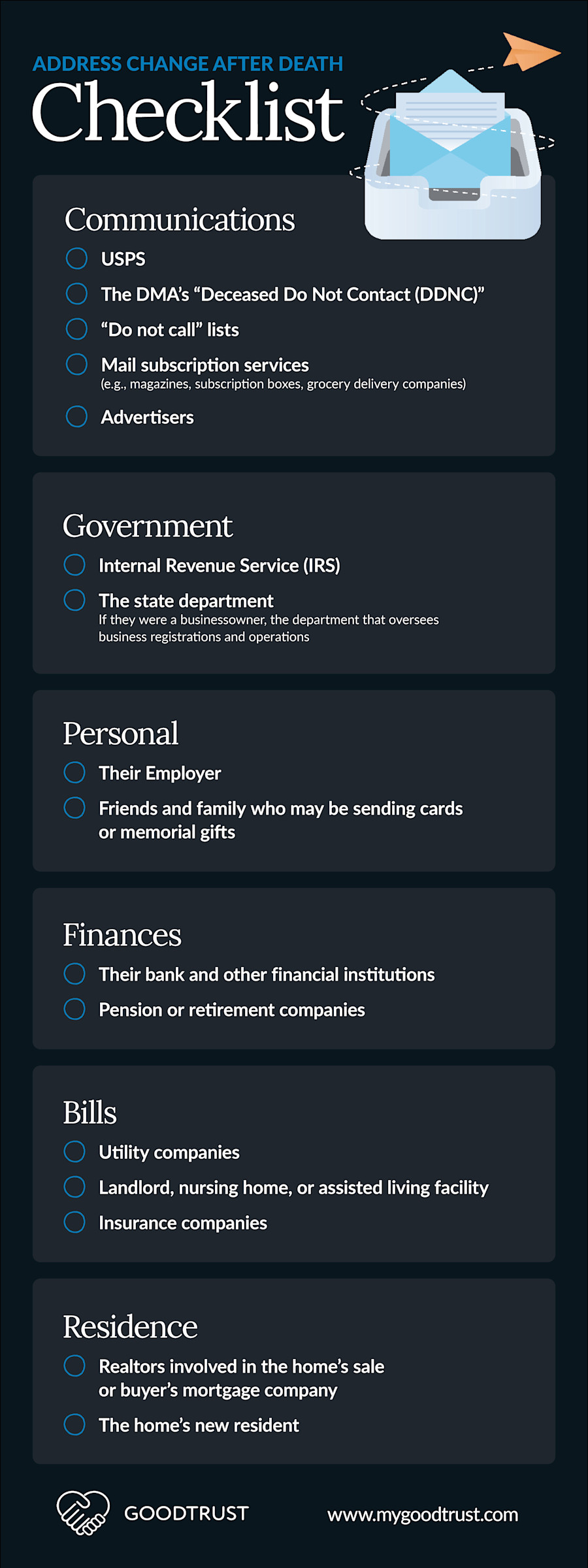
How To
How to Forward or Stop Mail for the Deceased | GoodTrust

You may have heard the phrase, "Neither snow nor rain nor heat nor gloom of night stays these couriers from the swift completion of their appointed rounds." While this isn't the United States Postal Service (USPS) official motto as is commonly believed, nearly nothing indeed stops the mail—including the deaths of the recipients.
This means deceased people's loved ones are responsible for forwarding or stopping their mail.
Unfortunately, it isn't quite as easy as making a phone call to the post office. That said, you can stop nearly all mail from arriving. Here, we'll discuss some of the basics.
How to Forward USPS Mail After Death
Whether alive or dead, forwarding mail means mail sent to a person goes to a new address.
There’s a lot going on when someone passes away but changing the deceased's address should be handled quickly.
Note: If you know no one will be able to deal with this for a few weeks, you should be able to have the post office hold an entire household's mail for up to 30 days, meaning the mail won't arrive at all during that time.
For a Deceased Loved One
You should forward a deceased loved one's mail if they lived alone or if the person they lived with can't emotionally or legally handle the mail.
There are three ways to forward the deceased person's mail:
If you lived with the person but need to forward the mail OR If you didn't live with the person and want to receive their mail: The deceased's executor needs to
Visit the post office.
Provide proof that they are the executor and allowed to change the decedent's mailing address.
Fill out a Forwarding Change of Address Form at the post office.
2. If you lived with the person and need to forward specific mail: Forward that mail as necessary, crossing out the current address and barcode, writing "Forward to [new address]" on the envelope, and dropping the mail in a place where it gets picked up.
Postal change of address (COA) forms can have official dates to begin forwarding mail on them, from 30 days in the past to 90 days in the future. USPS recommends filling out the form at least two weeks before the new address is necessary.
Whoever moves into your loved one's home after their death will receive all their mail if you don't fill out a postal change of address—meaning important papers may never make it to the person who needs to handle relevant issues.
Note: First Class Mail is only forwarded for 12 months, and periodicals are only forwarded for 60 days. The USPS expects that, within that time, you have contacted senders to let them know of the situation. After that time expires, mail will go to whatever address is on the envelopes. Therefore, you need to contact each place sending mail quickly to change the address or end subscriptions.
For a Deceased Former Resident
Let’s say you moved into a new place and are still receiving the mail of a former tenant or owner. You have options, but they’re a bit different than the steps above.
Unfortunately, you can't go to the post office and fill out any forms, even if you know the forwarding address.
The first and most common method is to forward mail piece by piece, especially early on:
If you know where the mail should be delivered:
Cross out the address, write the "Forward to [new address]" on the piece, and then put it in a mail drop. Crossing out the barcode is often advised, too. Mail is automatically sorted, and that same piece may end up back at your home if the barcode isn’t crossed out.
If you don't know where to send the mail:
Write "Not at this address" on the piece and drop the mail in an approved location. Do not cross out the current address.
If you don't know where to send the mail and know the person is deceased:
You can choose to write "Deceased, Return to Sender" on the mailer. This may stop mail from being delivered, but isn’t a guarantee.
You can also talk to your landlord or whomever you purchased the house from. They may have contact information for the executor or next of kin and can reach out to them about filling out a mail forwarding document.
Additionally, you can put a note to your postal carrier on your box, saying, "[Name] no longer lives here. Only deliver mail for [your name]." Again, this method isn't foolproof but may help.
Importantly, when mail is addressed to the previous owner "or current resident," you probably can't forward the message to the former resident or return it to the sender. It's legally yours.
In any other situation, the mail is not legally yours, and you are generally barred by federal law from opening, disposing of, or destroying it. In those cases, you need to forward the mail.
If you've exhausted all other options, contact USPS and file a complaint.
For Yourself
If you know you're not going to live much longer, setting up a forwarding address may be wise. However, this is a legal gray area, and you should contact USPS for advice. This is a gray area because it's a federal crime to open someone else's mail.
If it turns out you can't just send mail to someone else's address, consider having mail addressed to you "In care of" (C/O) so the post office knows the resident of that home is allowed to receive your mail—though C/O doesn't necessarily mean they can open it.
Since you don't know when you'll pass, it may be best to do this sooner than you hope to need to do it, just in case—especially if the new address is local and the homeowner can get your mail to you as needed.
You can fill out a COA form online for $1.05 or at the post office for free.
DMAchoice
A fast way to stop mail advertisements from reaching your mailbox is to register for DMAchoice, a service offered by the Data & Marketing Association.
Signing up for DMAchoice costs $2 and keeps many kinds of direct advertisements from coming to you, such as mail offers (credit cards, magazines, etc.), catalogs, and ads from competitors of companies you've shopped with. (If you have shopped with a company that sends you ads, you likely need to contact them directly to stop the mail.)
Caregivers may also register for the DMA on their loved one's behalf.
How Much Does Mail Forwarding for the Deceased Cost?
There are two types of USPS mail forwarding: standard and Premium.
Standard Mail Forwarding for the Deceased
You can sign up for standard mail forwarding for free at the post office, or for $1.05 if the change of address is completed online.
When you choose to permanently forward a deceased’s mail using the standard option, the following mail types are forwarded for:
First-Class mail: 12 months
Priority Mail: 12 months
Priority Mail Express: 12 months
First-Class Packages: 12 months
Periodical subscriptions (magazines, newspapers): 60 days
USPS will not forward USPS Marketing Mail unless forwarding instructions have been specified.
Premium Mail Forwarding for the Deceased
Premium Forwarding Service Residential (PFS-Residential) is meant to be an add-on to the standard mail forwarding option. It can be extended for up to one year and the fees are as follows:
Enrollment fees (non-refundable)
$20.90 if you enroll online
$22.75 if you enroll at the post office
Weekly fees
$22.75 for each week of service whether you enrolled in person or online.
With PFS-Residential, all mail is delivered in a single weekly batch via USPS’ Priority Mail® service, meaning it has tracking.
You can extend, shorten, or cancel your service at any time—there isn't a subscription aspect.
How to Stop Advertisement Mail to the Deceased
Advertisements addressed to the deceased can be stopped in several ways.
Above all, you should fill out the DMA's Deceased Do Not Contact (DDNC) registration form. This is free.
However, the DMA and DDNC won't stop all ads. If the deceased was an official customer or donor or the mail is from certain excluded groups, you need to contact the organization directly and tell them about the death.
Can I Stop All Mail to the Deceased?
If you're the executor of the deceased's estate and all relevant proceedings are complete, you can bring a copy of a probate order to the post office that services the decedent's address to end your participation as executor. Then, you can request to discontinue all mail service to that person.
That said, some mail may still arrive—particularly junk mail. Even as laws against this increase, businesses may find addresses for marketing purposes by purchasing them through direct mail companies, or they may decide to go back through old clients and start advertising to them for the first time in a good while. In these cases, you'll again need to contact the companies directly or, if possible, report them to any legally required opt-out group if that step was taken.
Their contact information may also be on websites that allow you to search for people’s contact information. Some of these sites allow advertisers to use the information they find, and others don't. The data doesn't disappear after death.
Additionally, an old friend or another person unaware of the death may send a letter after finding the information on such a site. To remove your loved one’s info from people search directories, you probably need to reach out to the sites individually.
It's worth noting that none of the information these sites gather is private—they scrape things like social media and other public sources. To further help stop unwanted mail, shut down any accounts where contact information may be or have once been public.
Here are some useful resources on:
Additionally, Google your loved one's name, address, email address, phone number, or other information to see where else it may be visible
No matter what, there's a chance mail with your loved one's name on it will continue to arrive for years to come. This could be because a company missed the memo (even if you contacted them), the contact information was found online, or they're using "or current resident." The postal service can't stop this from occurring and are legally bound to deliver that mail
Change of Address Checklist: Who to Update After Death

You likely need to contact many companies and people after someone dies. While some of these should be contacted for other reasons, like canceling subscriptions or utilities, providing a forwarding address may help wrap up any final details.
Some of those to consider providing with the new address or mail cancellation notices include:
USPS
The DMA's DDNC
Do not call lists
IRS
Their employer
Their bank and other financial institutions
Utility companies
Landlord, nursing home, or assisted living facility
Realtors involved in the home's sale or buyer's mortgage company
Insurance companies
Pension or retirement companies
The home's new resident
Friends and family who may be sending cards or memorial gifts
Mail subscription services (e.g., magazines, subscription boxes, grocery delivery companies)
Advertisers
If they were a businessowner, the state department that oversees business registrations and operations
How Digital Legacy Services Can Help with Mail Service for the Deceased
While using a digital afterlife service can't stop mail in a vacuum, it can speed up the process.
With GoodTrust, your loved one can create a will online and assign an executor to carry out all the mail forwarding and stop services once they are deceased. They can also assign trusted contacts to close social media accounts, online shopping accounts, subscription services, and many other online accounts that could include their address.
Forwarding mail for a deceased person isn't always a simple process! Make sure you and your loved ones are prepared and sign up for a free GoodTrust account today.